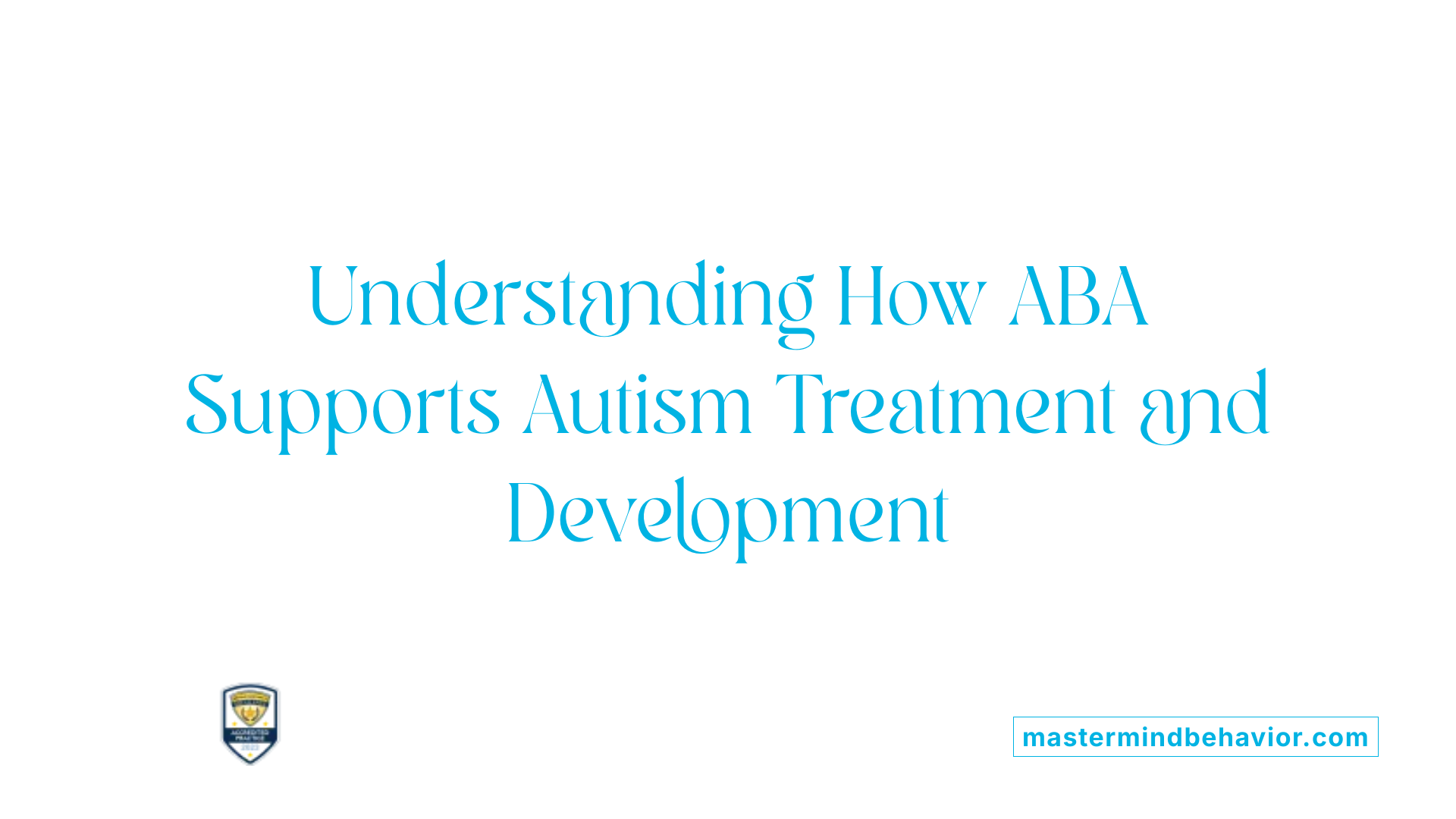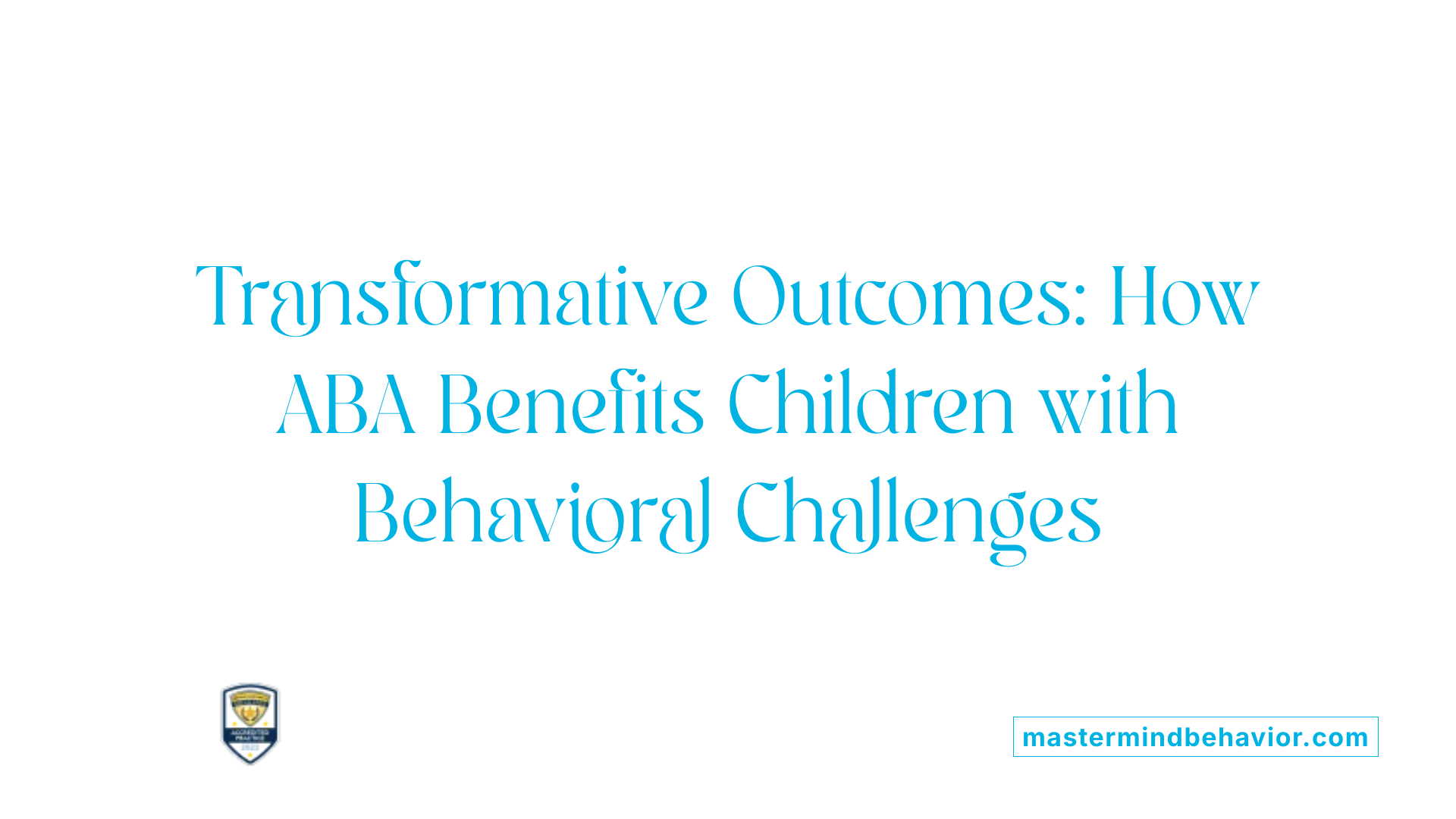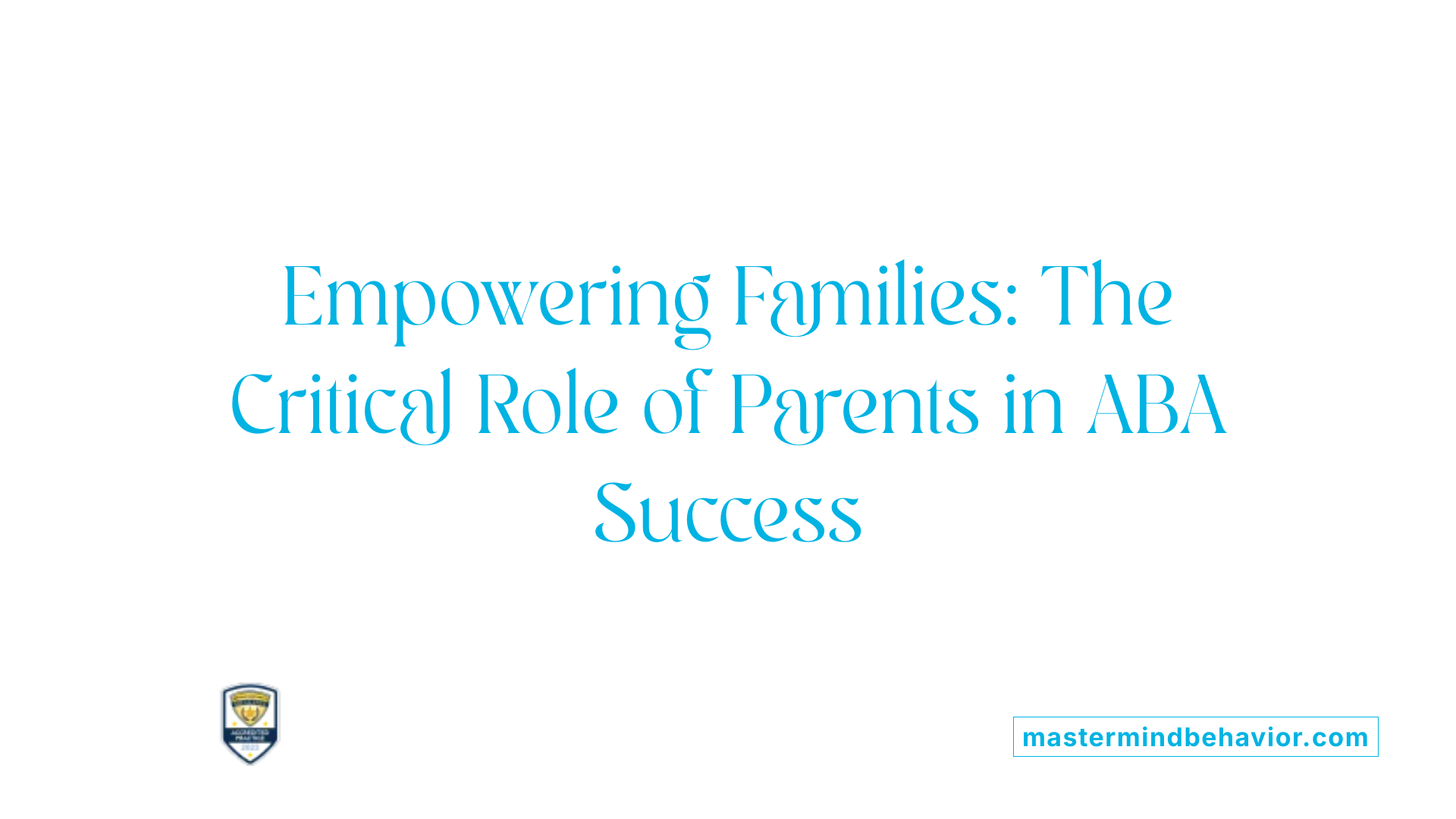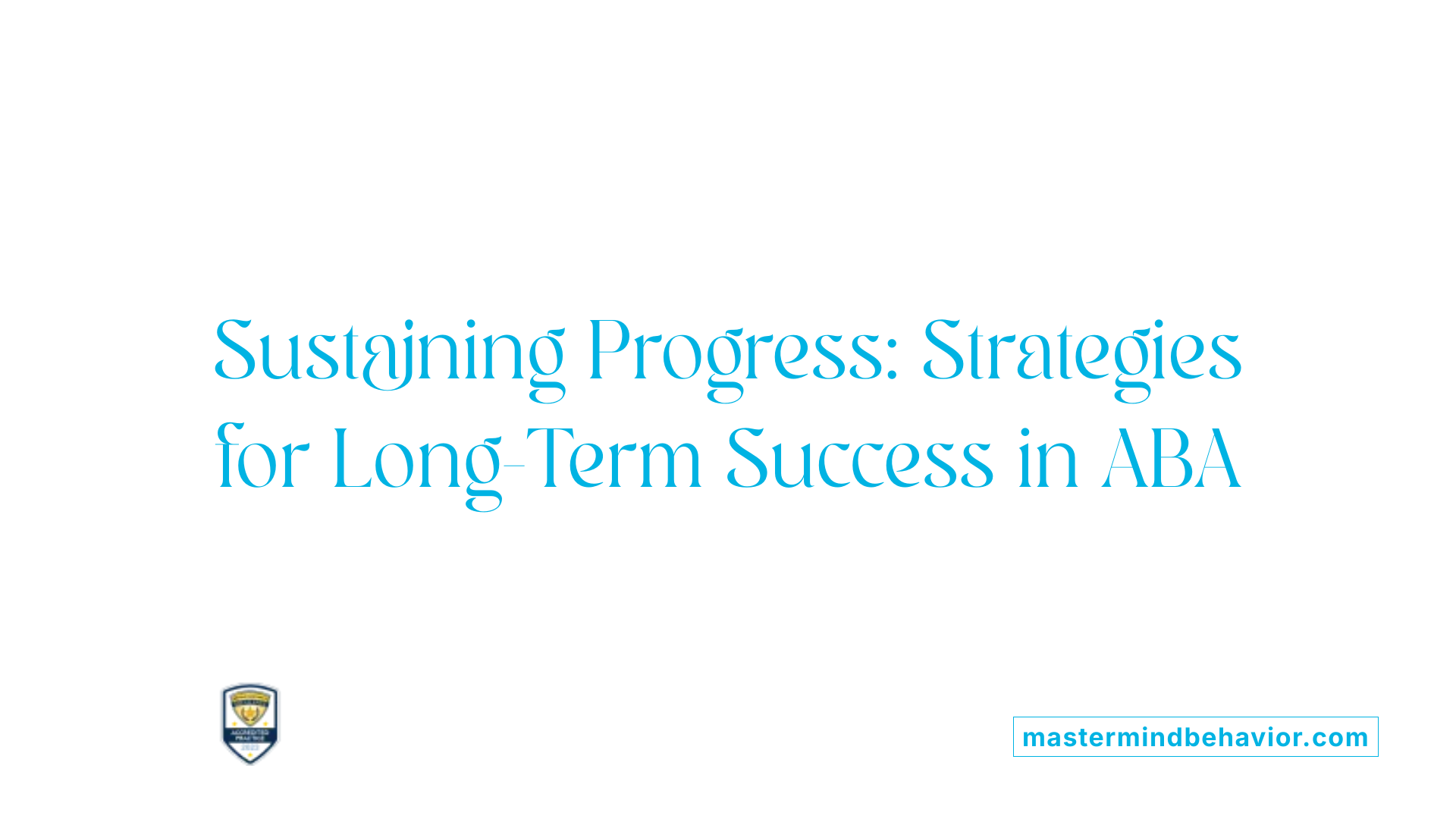Understanding What Is ABA: Principles Families Should Know

An Essential Guide for Families and Parents
Applied Behavior Analysis (ABA) is a scientifically validated approach that plays a crucial role in understanding and modifying behavior, especially for individuals with autism spectrum disorder (ASD). This comprehensive overview explores the fundamental principles of ABA, how therapy works, and its benefits, providing families with the knowledge they need to make informed decisions and actively participate in their child's development.
What is Applied Behavior Analysis (ABA)?
What is Applied Behavior Analysis (ABA)?
Applied Behavior Analysis (ABA) is a scientific discipline focused on understanding and modifying human behavior. It applies theories of learning and motivation to help individuals develop helpful skills and reduce harmful behaviors.
ABA primarily targets behaviors that are socially important, such as communication, social skills, and daily living activities. It emphasizes observable behaviors, meaning it looks at actions you can see and measure.
To develop effective interventions, ABA uses environmental factors and functional assessments. These assessments help identify what triggers certain behaviors and what maintains them over time.
The core principles of ABA include reinforcement, behavior analysis, and a systematic approach to behavior change. Reinforcement, especially positive reinforcement, involves offering a reward immediately after a desirable behavior to encourage its repetition.
Behavior analysis involves examining the ABCs: Antecedent, Behavior, and Consequence. This helps understand what happens before and after a behavior, guiding tailored strategies.
The systematic methodology in ABA involves collecting data meticulously, applying standardized procedures, and adjusting interventions based on ongoing progress.
Throughout its history, ABA has been extensively studied since the 1960s. Its evidence-based practices are especially important in autism treatment, where early intervention can lead to significant gains.
By focusing on observable actions and environmental influences, ABA offers a practical and effective way to support learning and behavioral improvements in diverse settings—home, school, or clinics.
How ABA Therapy Functions in Autism Treatment
 Applied Behavior Analysis (ABA) is grounded in the science of learning and behavior. It helps understand how behaviors are influenced by environmental factors and how to bring about positive change through targeted strategies.
Applied Behavior Analysis (ABA) is grounded in the science of learning and behavior. It helps understand how behaviors are influenced by environmental factors and how to bring about positive change through targeted strategies.
One of the strengths of ABA is its highly individualized approach. Trained professionals, often certified behavior analysts (BCBAs), design and oversee personalized programs tailored to each child's specific needs, skills, and goals. These programs are flexible and can be implemented in various settings, including home, school, or clinics, making them adaptable to different environments.
ABA employs a range of techniques to teach new skills and reduce problematic behaviors. Discrete Trial Training (DTT) is a structured method that involves clear, repeated teaching trials with immediate reinforcement. Naturalistic teaching, on the other hand, incorporates learning into everyday activities, making it more functional and engaging.
The primary goals of ABA therapy are to increase important skills—such as communication, social interaction, and daily living skills—while decreasing harmful or non-helpful behaviors. Techniques like positive reinforcement encourage children to repeat desirable actions by providing meaningful rewards immediately after the behavior.
Research shows that starting early, intensive ABA intervention results in better outcomes. When therapy begins before age five, children often achieve greater developmental gains, become more independent, and improve their social engagement. Consistent, data-driven adjustments ensure that interventions are effective and progress is continuously monitored.
| Technique | Description | Benefit |
|---|---|---|
| Discrete Trial Training | Structured, repeated teaching with clear steps | Builds foundational skills efficiently |
| Naturalistic Teaching | Learning through everyday interactions | Promotes functional skills |
| Positive Reinforcement | Rewards for desired behaviors | Encourages skill acquisition |
| ABC Model | Analyzing antecedents, behaviors, and consequences | Helps understand and modify behaviors |
In summary, ABA therapy applies scientifically validated principles to support children with autism, helping them learn new skills, reduce challenging behaviors, and improve overall functioning.
Benefits and Effectiveness of ABA for Children with Behavioral Challenges

What are the benefits of ABA for children with behavioral challenges?
Applied Behavior Analysis (ABA) provides a wide range of positive outcomes for children facing behavioral difficulties, especially those diagnosed with autism spectrum disorder (ASD). It is recognized as an evidence-based approach, grounded in scientific research, that targets essential developmental skills.
Through ABA, children can see marked improvements in communication, social interactions, academic abilities, and everyday life skills. The therapy employs proven techniques like positive reinforcement, which encourages desirable behaviors by rewarding them immediately. This method effectively promotes meaningful behavioral change.
Many children involved in ABA programs experience a reduction in harmful or problematic behaviors, such as tantrums or self-injury. Early intervention, particularly when started before age five, often leads to more significant progress. The tailored nature of ABA allows treatments to be adapted to each child's strengths and needs, fostering independence and social participation.
Overall, ABA helps children achieve greater levels of functioning and confidence. It paves the way for more successful integration into school and community settings, empowering children to reach their full potential.
How does ABA improve social skills, communication, and academics?
ABA programs focus heavily on developing social skills and communication. Using clear, observable behaviors and structured teaching methods, children learn to interact more effectively and understand social cues.
Academic skills are also targeted through repeated, systematic instruction, enabling children to grasp new concepts and improve their learning outcomes. Techniques such as data collection and regular progress reviews ensure interventions remain effective and adaptable.
In what ways does ABA reduce problem and harmful behaviors?
By understanding the antecedents that trigger unwanted behaviors, ABA uses strategies like extinction, punishment, and reinforcement to decrease these behaviors. Positive reinforcement is particularly emphasized to encourage alternative, more acceptable behaviors.
When harmful behaviors are reduced, children can participate more safely and comfortably in daily activities and social environments, supporting their overall well-being.
How does ABA promote independence and daily living skills?
ABA also emphasizes teaching practical skills needed for daily life, including self-care, communication, and task completion. These skills foster greater independence, making children more capable of managing everyday routines and engaging with their surroundings.
What scientific evidence supports ABA’s long-term benefits?
Research since the 1960s has consistently demonstrated ABA’s effectiveness through numerous studies. The therapy’s scientific foundation and structured approach continue to produce reliable, lasting improvements.
The American Psychological Association and the US Surgeon General endorse ABA as a best practice, further cementing its credibility.
How do long-term outcomes look for children undergoing ABA?
Children receiving intensive, long-term ABA interventions often show sustained improvements in behavior, communication, and social skills. Early treatment typically results in better functional independence and quality of life in adulthood.
Overall, ABA offers a comprehensive framework that supports children’s development across multiple domains, fostering positive, long-lasting outcomes.
Understanding an ABA Assessment Process
What does an ABA assessment involve?
An ABA assessment is a detailed and thorough process designed to evaluate a child's behaviors, skills, and developmental challenges. This assessment helps clinicians create personalized intervention plans tailored to the individual's needs. It begins with a comprehensive review of the child's current abilities in areas such as communication, social skills, daily living, and academic performance.
Trained professionals, including Behavior Analysts or Board Certified Behavior Analysts (BCBAs), lead this process. They often start with interviews with caregivers and teachers to gather valuable information about the child's behavior in different settings. This input helps identify observable behaviors that may need modification.
Direct observation plays a vital role during the assessment. Clinicians watch the child in naturalistic settings or during structured tasks to see how behaviors occur and how the environment influences them. Standardized assessments may also be used to measure specific skills or behaviors to obtain objective data.
A crucial part of the assessment is conducting a Functional Behavior Assessment (FBA). This process investigates the possible reasons for challenging behaviors by analyzing the antecedents (what happens before a behavior) and consequences (what happens after). The FBA helps identify triggers and functions of behaviors, enabling the development of targeted strategies.
The overall goal of the assessment is to gather enough information to set clear, achievable goals for increasing helpful behaviors and decreasing problematic ones. Ongoing data collection and progress monitoring are integral to the process, ensuring that interventions remain effective and are adjusted as the child's skills and needs evolve over time.
The Importance of Family and Parent Involvement in ABA

Why is understanding ABA important for families and parents?
Grasping the basics of Applied Behavior Analysis (ABA) is crucial for families and parents because it empowers them to actively participate in their child's intervention process. When parents understand how ABA works, they can make informed choices about therapy options and collaborate effectively with professionals.
Parent training is a significant component of successful ABA programs. It equips parents with the skills needed to reinforce positive behaviors at home, implement strategies consistently, and help their child develop essential skills that generalize across different environments.
Involving the family promotes better communication between caregivers and therapists, ensuring everyone is aligned in their approach. This consistency is vital for producing meaningful progress in behaviors, communication, social skills, and daily living activities.
Moreover, a good understanding of ABA enables parents to advocate strongly for their child's needs. They can ensure that ethical practices are maintained, and their child's rights are protected.
Finally, active family involvement fosters a stronger bond between parent and child, creating a supportive environment that encourages growth and resilience.
Supporting intervention at home
Parents play a central role in supporting ABA interventions outside of therapy sessions. They use techniques such as positive reinforcement—offering rewards for desirable behaviors—to encourage learning.
By integrating ABA strategies into daily routines, parents help children practice new skills in everyday settings, which leads to more consistent and durable behavioral improvements.
Consistency and communication between home and therapy
Maintaining clear communication with therapists ensures that home implementations align with professional guidance. Regular updates and shared data collection help in tracking progress and adjusting interventions as needed.
Consistency involves following recommended procedures, applying similar reinforcement techniques, and being patient and persistent, creating a stable environment for the child's development.
Parent training and collaboration
Training sessions teach parents how to understand the ABC model—Antecedent, Behavior, and Consequence—and how to use data to monitor changes.
Collaborating with clinicians allows parents to tailor interventions to their child's specific needs, ensuring a personalized approach. Such teamwork enhances the effectiveness of ABA services.
Advocacy and making informed decisions
Parents knowledgeable about ABA are better prepared to ask the right questions, evaluate provider credentials, and choose qualified practitioners. They can also advocate for coverage of ABA therapy through insurance and Medicaid when necessary.
Being informed supports ethical decision-making and helps parents navigate available resources, ultimately providing the best support for their child's growth.
| Aspect | Role in ABA Involvement | Examples of Implementation or Benefits |
|---|---|---|
| Parental Knowledge | Foundation for involvement | Understanding ABA principles enhances decision-making and skill reinforcement |
| Home Support | Reinforces therapy goals | Using positive reinforcement at home for daily behaviors |
| Communication | Ensures program consistency | Regular updates and data sharing between parents and therapists |
| Collaboration | Personalizes intervention | Parents participate in goal setting and review processes |
| Advocacy and Decision-Making | Secures necessary resources | Ensuring insurance coverage and obtaining qualified providers |
By staying involved and informed, families significantly boost their child's chances for meaningful progress and well-being in ABA therapy.
Implementing ABA: Strategies and Settings
How is ABA therapy implemented to support children with autism?
ABA therapy begins with comprehensive assessments conducted by qualified behavior analysts. These professionals develop personalized, structured intervention programs tailored to each child's individual needs and developmental goals. The core of ABA implementation relies on the ABC model — Antecedent, Behavior, and Consequence — which helps identify triggers, behaviors, and outcomes to modify or reinforce.
In practice, therapists use various techniques such as positive reinforcement — providing rewards immediately after desirable behaviors to encourage repetition — and prompting, which guides children toward the correct response. Often, therapy involves naturalistic teaching methods that integrate learning into everyday situations, making skills more relevant and easier to generalize.
Caregivers and teachers play a vital role in ABA programs. They are trained to consistently apply specific strategies across different settings, ensuring that behaviors learned during therapy are reinforced throughout daily life. This consistent approach helps children develop communication, social, and self-care skills more effectively.
Ongoing data collection is a fundamental part of ABA. Regular assessments of the child's progress inform necessary adjustments to intervention plans, ensuring that goals remain aligned with the child's evolving needs. Through continuous monitoring, ABA programs can sustain improvements in social interaction, reduction of problem behaviors, and overall developmental progress.
Overall, ABA therapy aims to foster a supportive environment where children with autism can learn essential skills, improve behavior, and increase their independence, leading to better integration into their communities.
The Seven Dimensions of ABA and Ethical Practice

What are the seven dimensions of ABA?
The seven dimensions of Applied Behavior Analysis (ABA) are foundational principles that guide its application to ensure effectiveness, consistency, and scientific integrity. These dimensions include applied, behavioral, analytic, technological, conceptually systematic, effective, and generality.
"Applied" signifies that ABA targets behaviors that are socially meaningful and impactful for individuals and their communities. "Behavioral" emphasizes that interventions focus on observable actions rather than internal thoughts or feelings.
"Analytic" involves a data-driven approach, where ongoing data collection guides decision-making and demonstrates that behavior change is reliably due to the interventions. "Technological" refers to procedures being clearly defined and replicable, so that others can precisely implement the interventions.
"Conceptually systematic" means that interventions are rooted in behavioral principles, ensuring consistency and scientific validity. "Effective" emphasizes that interventions lead to meaningful and measurable improvements in behaviors. Finally, "generality" aims for behavior changes to be durable, applicable across various settings, and maintained over time.
Adhering to these dimensions ensures high standards of quality, scientific rigor, and ethical practice in behavior analysis.
Guidelines for ethical practice
Ethical practice in ABA involves respecting client rights, obtaining informed consent, maintaining confidentiality, and ensuring interventions are used responsibly. Behavior analysts should always prioritize the well-being of their clients and work within professional guidelines.
Professionals are advised to seek ongoing education and supervision, especially when designing or modifying programs. Transparent communication with families and stakeholders is crucial for ethical compliance.
Cultural considerations and parent education
Cultural competence is vital in ABA. Practitioners should consider the cultural backgrounds of clients and families to tailor interventions appropriately. Respecting family values and involving parents in decision-making fosters trust and improves outcomes.
Providing thorough parent education and training empowers caregivers to support and reinforce strategies outside of therapy sessions. Clear, accessible resources help parents understand behavioral principles and participate actively.
Ensuring scientific integrity
Maintaining scientific integrity means using evidence-based procedures, systematic data collection, and ongoing evaluation. ABA practitioners should rely on validated methods, document progress meticulously, and adjust interventions based on data.
Peer review, continued research, and transparency further uphold the scientific standards of ABA. This commitment ensures that behavior analysis remains a credible, effective, and ethical discipline.
| Dimension | Description | Purpose |
|---|---|---|
| Applied | Targets socially significant behaviors | Ensures relevance and impact |
| Behavioral | Focuses on observable actions | Facilitates measurable change |
| Analytic | Uses data to demonstrate functional relationships | Validates effectiveness |
| Technological | Procedures are clearly defined and replicable | Maintains consistency and clarity |
| Conceptually systematic | Rooted in behavioral science principles | Ensures scientific integrity |
| Effective | Leads to meaningful improvements | Achieves desired outcomes |
| Generality | Behavior change persists across settings and over time | Promotes long-lasting benefits |
This comprehensive approach underscores the importance of ethical standards, cultural sensitivity, and scientific rigor in delivering effective ABA services.
Supporting Family Success and Sustaining Outcomes

How can families sustain the benefits of ABA?
Maintaining the positive results achieved through ABA therapy requires active participation from families. One crucial step is ongoing training. Parents and caregivers can learn strategies to reinforce skills and behaviors at home, turning therapy insights into daily routines.
Establishing consistent routines is another vital aspect. When routines are predictable and supportive, children can better generalize learned skills across different settings, boosting confidence and independence.
Collaboration plays a significant role. Families should work closely with educators, therapists, and healthcare providers. Regular communication and sharing of progress updates enable tailored adjustments to intervention plans.
Monitoring progress regularly allows families to identify emerging challenges early. This data-driven approach ensures that goals are continuously updated and interventions remain effective.
Community involvement is also valuable. Encouraging participation in social activities and community programs helps children apply skills in varied environments, promoting social integration.
Finally, ongoing assessment and adaptation are essential. Families that stay engaged with therapy teams and support continuous learning can sustain long-term improvements. By committing to these strategies, families foster a nurturing environment that reinforces ABA’s benefits, ensuring children’s growth and development are supported well beyond the therapy sessions.
Empowering Families with Knowledge and Action
Understanding the core principles of ABA and how it can be effectively applied to support children with autism is vital for families. Active participation, ongoing education, and collaboration with qualified professionals ensure that interventions are tailored to each child's needs. By embracing these principles, families can foster meaningful progress, maximize their child's potential, and build a brighter future grounded in scientifically supported strategies.
References
- Applied Behavior Analysis (ABA)
- ABA Principles
- Helping Parents Understand Applied Behavior Analysis
- What Parents Need to Know About ABA Therapy for Autism
- Understanding ABA Therapy for Parents | IABS
- Applied Behavior Analysis (ABA)
- The Top 10 Reasons Children With Autism Deserve ABA
- Applied Behavior Analysis (ABA) for Children With Autism
- Applied Behavior Analysis (ABA)
Recent articles

What Families Should Know About ABA Therapy Ethics And Consent
Understanding the Foundations and Ethical Framework of ABA Therapy

How ABA Providers Can Help Teachable Moments Arise Throughout the Day
Creating Learning Moments Anywhere: The Role of ABA Providers in Everyday Development

How to Navigate Autism Laws and Legal Support Services In NJ And GA
Comprehensive Legal Frameworks Supporting Autism Therapy in NJ and GA

How ABA Therapy Improves Adaptation To New School Environments
Supporting Children with Autism Transitioning into School through ABA Therapy

Strategies For Building Peer Relationships Through ABA Social Skills Training
Building Meaningful Peer Connections with ABA-Based Social Skills Training

How ABA Therapy Improves Communication With Teachers And Peers
Empowering Social Connections: The Role of ABA Therapy in Autism



